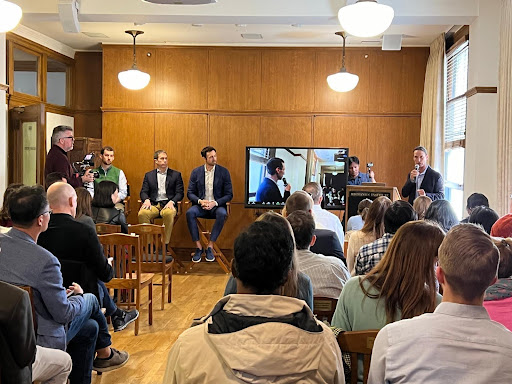Close
SF Climate Week — April 23, 2024 — The Oppenheimer Project, collaborating with Anthropocene Institute, hosted a panel at the Mechanics Institute to discuss the need for nuclear energy as a scalable solution to meet the escalating power needs of AI and datacenters and to support a clean energy economy.
Distinguished speakers included Dr. Vanessa Chan, Chief Commercialization Officer for the Department of Energy and Director of the Office of Technology Transitions; Jeffrey Donovan, Communication, Outreach, and Stakeholder Involvement for the International Atomic Energy Agency (IAEA); Brian Gitt, Head of Business Development at Oklo; Matt Lucas, Managing Partner at Tuatara Development Capital; and Jon-Michael Murray, REPOWER Program Director at Terra Praxis. Charles Oppenheimer moderated the discussion.

Dr. Vanessa Chan

[from L to R) Lucas, Brian Gitt, Jon-Michael Murray and Charles Oppenheimer]
The discussion centered on strong recent demand signals, including Microsoft, Google, and Nucor working together to aggregate demand for advanced clean electricity technologies; Equinix signing a pre-agreement with small nuclear reactor firm Oklo to procure up to 500MW of nuclear energy; and Amazon buying a nuclear-powered data center from Talen. Given pent-up demand, participants sought to answer the question: How can we bring more financing and streamline the path for nuclear energy projects?
Vanessa Chan started the discussion by emphasizing the need for a committed order book of small modular reactors (SMRs), a robust workforce, streamlined testing and licensing processes, and addressing cost overruns to scale nuclear energy. She also talked about the importance of nuclear energy in meeting the demand for clean, stable energy and creating good-paying jobs.
Donovan provided an overview of the IAEA, including its role in non-proliferation and supporting nuclear energy’s acceptance in the global energy and climate conversation. He highlighted recent “national commitments to using nuclear energy, not just for climate change mitigation, but for achieving energy supply, security, grid reliability, and price predictability. All those things are needed along with decarbonization.”
Additionally, speakers addressed regulatory hurdles and financing challenges, with a focus on international cooperation and practical deployment solutions. Murray laid out the challenge: “The nuclear sector, including the government, the regulatory agencies, and the industry itself, have successfully engineered a product that is hard to buy and invest in. The solutions we have today are mostly aimed at adapting to risks, like pooling resources or demand aggregation, but none of those approaches are sufficient to meet the scale that we need in the next few decades to repower coal facilities and other industrial infrastructure, or to meet the energy demand of rapidly growing energy users like data centers.”
Charles Oppenheimer then addressed the issue of speed and the urgent need for more energy now, especially for data centers. “This is not like spinning up the millionth substantiation of your app,” said Lucas. “The bits-and-bytes crowd and the nuts-and-bolts crowd have to interface. It may be that nuclear power in data centers is where we're going to find the nexus. But there's no magic bullet. Building a nuclear plant is going to take seven years, just like building a coal power plant would.” He then laid out the timeline, including environmental reviews, up-front engineering, actual construction, and ramp-up. “It’s not a nuclear problem. It’s an everything problem,” he said.
Oppenheimer noted that the big difference on the project finance side is that investors are accustomed to large paybacks on projects that take a long time to come to fruition. Gitt summarized what needs to be done: Design a product that is rapidly configurable to end-user requirements. Go smaller and standardize the reactor to pull the work from the construction environment into the more efficient factory environment. Push for changes in the regulatory environment. And, as Oklo has done, “Streamline a one-step process through the NRC. Because we design, build, and operate our own plants, we can get the construction license and the operational license at the same time,” he said.
The discussion then turned to manufacturing. The plan is that just as the data center industry has built a science of designing, configuring, and building data centers within months, the nuclear industry can do the same through integrated modularization and manufacturing processes.
Finally, Oppenheimer asked if there is a need to aggregate demand. “I don’t think it’s necessary,” said Gitt. “Amazon deployed 8.4 gigawatts of renewables last year. There’s plenty of demand with large tech companies. However, it is valuable for them to coordinate and work together on policy and to put pressure on Congress on the NRC to drive this forward.” Murray added, “So far, reactor vendors have been unable to deliver products that meet the demands of energy end-users. We really must bring everything together in an integrated approach that can deliver at speed and scale.”
Learn more about the Oppenheimer Project’s mission of international cooperation and advancing a safer future in the face of rapid technological change.